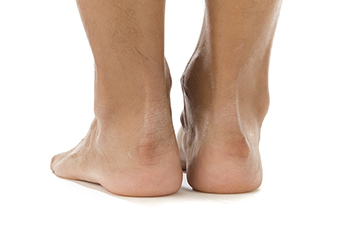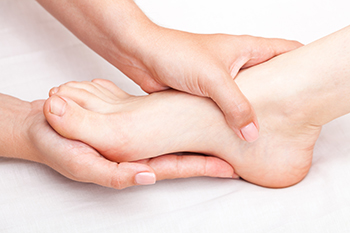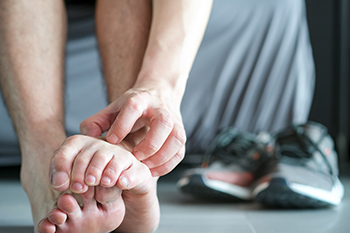August 2022
Several Reasons for Poor Circulation in the Feet

Poor circulation in the feet is common among diabetic patients. Acrocyanosis, which is a condition that can affect the extremities, and arteriosclerosis which can be triggered by high blood pressure are other reasons why this condition can develop. Poor circulation in the feet is the result of closed or narrow blood vessels, and patients who have this may be at risk for other health issues. Some of the symptoms that are associated with this condition include hair loss on the feet and legs, and dry or cracked skin. Additionally, people who have poor circulation may have weak toenails, and their feet may feel cold and have a bluish tint. The medical condition known as Raynaud’s disease syndrome may cause the blood vessels in the feet to become narrow, and this can limit the amount of blood that circulates. Additionally, peripheral artery disease (PAD) may contribute to poor circulation. This can cause the inability to feel existing cuts and scrapes that may have developed on the feet as a result of excessive plaque build up in the arteries. If you have poor circulation in your feet for any reason, please contact a podiatrist who can properly diagnose and treat this ailment.
While poor circulation itself isn’t a condition; it is a symptom of another underlying health condition you may have. If you have any concerns with poor circulation in your feet contact one of our podiatrists of Piedmont Podiatry Associates. Our doctors will treat your foot and ankle needs.
Poor Circulation in the Feet
Peripheral artery disease (PAD) can potentially lead to poor circulation in the lower extremities. PAD is a condition that causes the blood vessels and arteries to narrow. In a linked condition called atherosclerosis, the arteries stiffen up due to a buildup of plaque in the arteries and blood vessels. These two conditions can cause a decrease in the amount of blood that flows to your extremities, therefore resulting in pain.
Symptoms
Some of the most common symptoms of poor circulation are:
- Numbness
- Tingling
- Throbbing or stinging pain in limbs
- Pain
- Muscle Cramps
Treatment for poor circulation often depends on the underlying condition that causes it. Methods for treatment may include insulin for diabetes, special exercise programs, surgery for varicose veins, or compression socks for swollen legs.
As always, see a podiatrist as he or she will assist in finding a regimen that suits you. A podiatrist can also prescribe you any needed medication.
If you have any questions, please feel free to contact one of our offices located in Greenville, and Easley, SC . We offer the newest diagnostic and treatment technologies for all your foot care needs.
Exercises May Help Hammertoe

A foot condition that is considered to be a deformity can be referred to as hammertoe. It is a noticeable ailment that affects the toes, and pushes them into a bent position. The joint bends downward, often resembling a hammer. It is most often seen in the second, third, or fourth toes, and can cause difficulty in walking. It is known as an imbalance that affects muscles, toes, and ligaments, and may happen for various reasons. Some people have a predisposition to developing hammertoe, or it can come from wearing shoes that do not fit correctly. Additionally, it may happen if a foot injury has occurred, or from having weak calf muscles. Relief can be found when specific foot stretches are done, and performing regular exercise promotes healing and can improve flexibility. If you have this condition, please schedule an appointment with a podiatrist who can determine what the best course of treatment is for you.
Hammertoes can be a painful condition to live with. For more information, contact one of our podiatrists of Piedmont Podiatry Associates. Our doctors will answer any of your foot- and ankle-related questions.
Hammertoe
Hammertoe is a foot deformity that occurs due to an imbalance in the muscles, tendons, or ligaments that normally hold the toe straight. It can be caused by the type of shoes you wear, your foot structure, trauma, and certain disease processes.
Symptoms
- Painful and/or difficult toe movement
- Swelling
- Joint stiffness
- Calluses/Corns
- Physical deformity
Risk Factors
- Age – The risk of hammertoe increases with age
- Sex – Women are more likely to have hammertoe compared to men
- Toe Length – You are more likely to develop hammertoe if your second toe is longer than your big toe
- Certain Diseases – Arthritis and diabetes may make you more likely to develop hammertoe
Treatment
If you have hammertoe, you should change into a more comfortable shoe that provides enough room for your toes. Exercises such as picking up marbles may strengthen and stretch your toe muscles. Nevertheless, it is important to seek assistance from a podiatrist in order to determine the severity of your hammertoe and see which treatment option will work best for you.
If you have any questions, please feel free to contact one of our offices located in Greenville, and Easley, SC . We offer the newest diagnostic and treatment technologies for all your foot care needs.
What Is Ledderhose Disease?

There is a rare foot condition that is known as Ledderhose disease, which causes hard lumps to develop on the bottom of the feet. It is a result of a build up of connective tissue, and can cause pain and discomfort. The lumps are generally benign, and can be related to other connective tissue diseases. Additional symptoms include foot and ankle pain, tight skin, and a sensation of pins and needles. There may be existing conditions that lead to Ledderhose disease, including chronic liver disease, prior foot injuries, and diabetes. Patients with a long history of alcohol use may experience symptoms of this condition. Mild relief may be found when soft shoe inserts are worn to provide adequate padding for the bumps. It can be beneficial to perform mild stretches, and many patients find it can help to get regular foot massages. If you have any of these symptoms, it is suggested that you consult with a podiatrist for a proper diagnosis and treatment options that may involve surgery for permanent relief.
Some foot conditions may require additional professional care. If you have any concerns, contact one of our podiatrists of Piedmont Podiatry Associates. Our doctors can provide the care you need to keep you pain-free and on your feet.
Rare Foot Conditions
The majority of foot conditions are common and can be treated by a podiatrist. Standard diagnostic procedures are generally used to identify specific conditions and treatment can be rendered. A podiatrist also treats rare foot conditions which can be difficult to diagnose and may need extra attention and care.
There are many rare foot conditions that can affect children. Some of these can include:
- Freiberg’s disease
- Kohler’s disease
- Maffucci syndrome
Freiberg’s disease - This can be seen as a deterioration and flattening of a metatarsal bone that exists in the ball of the foot. It typically affects pre-teen and teenage girls, but can affect anyone at any age. Symptoms that can accompany this can be swelling, stiffness, and the patient may limp.
Kohler’s disease - This often targets the bone in the arch of the foot and affects younger boys. It can lead to an interruption of the blood supply which ultimately can lead to bone deterioration. The patient may limp or experience tenderness, swelling, and redness.
Maffucci syndrome - This affects the long bones in a child’s foot leading to the development of abnormal bone lesions. They are benign growths and typically develop in early childhood and the bones may be susceptible to breaking.
A podiatrist can properly diagnose and treat all types of rare foot conditions. If your child is affected by any of these symptoms or conditions, please don’t hesitate to call our office so the correct treatment method can begin.
If you have any questions please feel free to contact one of our offices located in Greenville, and Easley, SC . We offer the newest diagnostic tools and technology to treat your foot and ankle needs.
Definition and Symptoms of Tarsal Tunnel Syndrome

Common symptoms of the foot condition that is known as tarsal tunnel syndrome can include pain, numbness, and weakness in the toes and foot. There is a part of the foot that is called the tarsal tunnel, and is found between the ligaments that run across the foot and the inside of the ankle. Movement and flexibility are made possible by the nerves, arteries, and tendons that are within this tunnel, and repeated pressure on the nerves can cause tarsal tunnel syndrome. This can happen as a result of wearing tight shoes, an existing bony overgrowth in the ankle, or from a foot injury. Additionally, there may be current medical conditions that can cause this condition, such as diabetes, arthritis, or a thyroid disorder. Other symptoms that patients can experience include foot or toe pain, a sensation of an electric shock around the ankle or sole of the foot, and possible swelling. Relief may be found when compression stockings are worn, and specific medicine is prescribed. If you have developed this ailment, it is suggested that you are under the care of a podiatrist who can effectively diagnose and treat tarsal tunnel syndrome.
Tarsal tunnel syndrome can be very uncomfortable to live with. If you are experiencing tarsal tunnel syndrome, contact one of our podiatrists of Piedmont Podiatry Associates. Our doctors can provide the care you need to keep you pain-free and on your feet.
Tarsal Tunnel Syndrome
Tarsal tunnel syndrome, which can also be called tibial nerve dysfunction, is an uncommon condition of misfiring peripheral nerves in the foot. The tibial nerve is the peripheral nerve in the leg responsible for sensation and movement of the foot and calf muscles. In tarsal tunnel syndrome, the tibial nerve is damaged, causing problems with movement and feeling in the foot of the affected leg.
Common Cause of Tarsal Tunnel Syndrome
- Involves pressure or an injury, direct pressure on the tibial nerve for an extended period of time, sometimes caused by other body structures close by or near the knee.
- Diseases that damage nerves, including diabetes, may cause tarsal tunnel syndrome.
- At times, tarsal tunnel syndrome can appear without an obvious cause in some cases.
The Effects of Tarsal Tunnel Syndrome
- Different sensations, an afflicted person may experience pain, tingling, burning or other unusual sensations in the foot of the affected leg.
- The foot muscles, toes and ankle become weaker, and curling your toes or flexing your foot can become difficult.
- If condition worsens, infections and ulcers may develop on the foot that is experiencing the syndrome.
A physical exam of the leg can help identify the presence of tarsal tunnel syndrome. Medical tests, such as a nerve biopsy, are also used to diagnose the condition. Patients may receive physical therapy and prescriptive medication. In extreme cases, some may require surgery.
If you have any questions please feel free to contact one of our offices located in Greenville, and Easley, SC . We offer the newest diagnostic and treatment technologies for all your foot and ankle needs.
Do Your Child's Feet Hurt?
Parts of the Foot Affected by Athlete’s Foot

A common foot infection is known as athlete’s foot. Its medical term is tinea pedis, and it is caused by a fungus. This type of fungus lives and thrives in warm and moist environments, including public shower room floors, and locker rooms. It is beneficial to wear appropriate shoes while in these types of areas, and to refrain from sharing socks, shoes, and towels. Common symptoms that are associated with athlete’s foot consist of itchy feet, the soles may turn red and become dry, and the skin may crack between the toes. A proper diagnosis can include having a podiatrist examine the feet, often followed by having a sample taken of infected skin. Many times medication is prescribed that can provide mild relief for the itching and scaling. Effective prevention methods include washing and drying the feet daily, followed by wearing a clean pair of socks, and alternating the shoes that are worn. Additionally, it is beneficial to wear shoes that are made of breathable materials and to avoid wearing shoes made of vinyl. If you have questions about relief for athlete’s foot, please confer with a podiatrist who can determine what the best course of treatment is for you.
Athlete’s foot is an inconvenient condition that can be easily reduced with the proper treatment. If you have any concerns about your feet and ankles, contact one of our podiatrists from Piedmont Podiatry Associates. Our doctors will treat your foot and ankle needs.
Athlete’s Foot: The Sole Story
Athlete's foot, also known as tinea pedis, can be an extremely contagious foot infection. It is commonly contracted in public changing areas and bathrooms, dormitory style living quarters, around locker rooms and public swimming pools, or anywhere your feet often come into contact with other people.
Solutions to Combat Athlete’s Foot
- Hydrate your feet by using lotion
- Exfoliate
- Buff off nails
- Use of anti-fungal products
- Examine your feet and visit your doctor if any suspicious blisters or cuts develop
Athlete’s foot can cause many irritating symptoms such as dry and flaking skin, itching, and redness. Some more severe symptoms can include bleeding and cracked skin, intense itching and burning, and even pain when walking. In the worst cases, Athlete’s foot can cause blistering as well. Speak to your podiatrist for a better understanding of the different causes of Athlete’s foot, as well as help in determining which treatment options are best for you.
If you have any questions please feel free to contact one of our offices located in Greenville, and Easley, SC . We offer the newest diagnostic and treatment technologies for all your foot and ankle needs.





